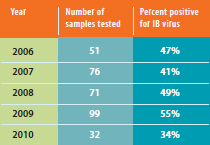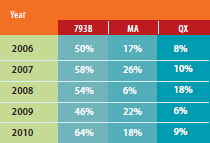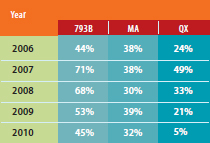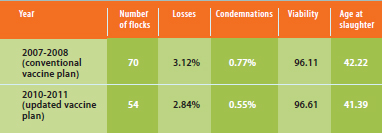



A 5-year summary of test results by a diagnostic
laboratory in Europe shows that infectious
bronchitis (IB) virus is clearly the most prevalent
respiratory disease among poultry, reported Brice
Robineau, DVM, of Finalab, which specializes in
veterinary biological analysis.
While the tests involved poultry flocks only in
France — Europe’s top producer of chicken
meat — the data provide a meaningful snapshot
of the prevalence and diversity of the IB virus.
In 2009, the year with the greatest number of
samples, more than half of layers and breeders
tested were positive for IB virus. Between 2007
and 2010, an average of 45.2% tested positive.
In 2010, the number of positive tests tapered off
to 34%, but Robineau said some of the samples
submitted could not be typed, possibly because
the virus is a new genotype not sensitive to
polymerase chain reaction testing.
According to Robineau, the most common IB virus
strain circulating is the variant 793B (Table 2),
which first appeared in France in 2005. The 793B
variant is of the same Protectotype as IB 4/91,
which means it has cross-protective ability.
The next most often found IB virus strains were
Massachusetts and the variant QX, he said,
explaining that the study was based on samples
sent by farmers or technicians who suspected
infectious respiratory disease.
In broilers, Robineau said, 81% were positive for
IB virus in 2010, up from 76% in 2009. Again,
the majority of IB virus strains found were 793B,followed by the Massachusetts then QX IB virus
strains, but the percentage positive for 793B
was not as high as it was in the previous 3 years.
Sentinel Layer Study

for broilers
To further assess the prevalence of IB viruses,
Finalab also conducted a study in 2011 using
sentinel birds involving six layer farms in France.
Between six to 10 specific-pathogen-free birds
were placed on each of the farms, which were all
contaminated with IB virus.
This study further demonstrated that 793B was
the most prevalent IB virus circulating. It also
showed that sentinel birds not vaccinated for
IB were contaminated by the production birds,
he said.
Improved Results
In a third study, Finalab compared two vaccination
protocols on five broiler farms with high IB pressure.
Protocol 1, used in 2007 and 2008, began with
a conventional IB H120 vaccine in the hatchery
and a booster at 14 days of age with IB virus 4/91
in the field. The H120 vaccine is based on the
Massachusetts IB serotype.
Beginning in 2009, the farms started transitioning
to Protocol 2, which consisted of Ma5
(Massachusetts) and 4/91 vaccines administered
at the hatchery. By 2010, all five farms were using
Protocol 2. Several production parameters, such as
condemnation and age at slaughter, were better
with the updated vaccination plan (Table 4), while
daily weight gain and the feed-conversion ratio
was comparable between the two regimens,
Robineau said.
The veterinarian concluded that for broilers in an
area with high IB virus pressure due to 793B IB virus
variant and possibly to the QX IB virus strain, “vaccination
with H120 followed by field vaccination at
14 days can be replaced with vaccination that can
be done in the hatchery to prevent the degradation
of performance by IB virus contamination.
“What’s remarkable, in my opinion, is that the 793B
virus has been very stable over the years,” he said.
For long-lived birds such as layers and breeders,
Robineau said the vaccination plan would depend
on the situation in a given area or on a given farm,
but “our strategy is to use a lot of live vaccines
providing broad protection, then to booster with
inactivated vaccines.
“You have to get immunity very early, during
the first weeks of life, to prevent damage to the
reproductive tract. You have to use multiple
variants and booster for them,” he said.
More Issues









